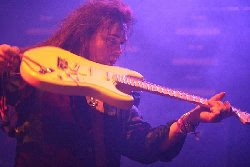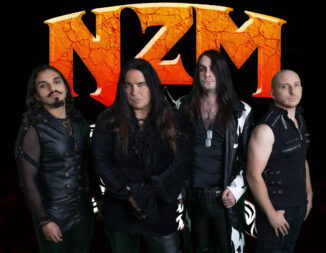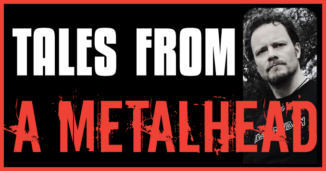
Over the years each decade has managed to produce musicians who have pushed the boundaries of guitar playing back further and further. In the 60s, Jimi Hendrix stunned the music world with his revolutionary technique, his innovative use of distortion and effects, and his over the top showmanship, setting the bar for Rock music guitarists. Many thought that Hendrix would never be matched. In the back end of the 1970s, Eddie Van Halen turned the guitar world on its head with a unique finger tapping style and fluid speed, which spawned thousands of imitators. Moving into the 80s, the likes of Joe Satriani and Steve Vai continue to redefine playing for a new generation. Amongst the new breed of guitarists was one Yngwie J. Malmsteen. Hailing from Sweden, he first cut his teeth on the U.S. Metal band Steeler before being snapped up by former Rainbow singer Graham Bonnet for his band Alcatrazz, and began to show the Metal world a startling neo-Classical-based style, which fused his Rock influences of Ritchie Blackmore and Uli Jon Roth with the Classical world of Paganini and Bach. It was when Malmsteen broke free from the constraints of a band and began to establish himself as a solo artist that he honed and developed his unique style that was a world away from the traditional Blues scales adopted by the majority of the Rock world.
 It’s been nearly 25 years since Malmsteen’s debut release hit the streets to much critical acclaim, and this was his very first appearance in Newcastle since that landmark album. Such was the interest in Malmsteen’s appearance that the show was switched from the smaller Academy 2 to the main hall to accommodate the larger crowd.
It’s been nearly 25 years since Malmsteen’s debut release hit the streets to much critical acclaim, and this was his very first appearance in Newcastle since that landmark album. Such was the interest in Malmsteen’s appearance that the show was switched from the smaller Academy 2 to the main hall to accommodate the larger crowd.
With a surprisingly early start time of 8:00 pm, Malmsteen arrived on stage shrouded in a cloak of dry ice, and as “Rising Force” thundered from the speakers, at times all you could see of Malmsteen was the top of his head and his upraised fist. As the “smoke” began to clear, Malmsteen set off a flurry of notes in a myriad of keys and modes to dazzle the accumulated wide eyes and open mouthed guitar musos huddled by the crash barrier, hanging onto every note, scale, and triplet that emanated from his Fender Strat.
 Malmsteen has over the years worked with many vocalists including Jeff Scott Soto, Joe Lynn Turner, and Mark Boals. By his side now is none other than former Judas Priest throatsmith, Tim “Ripper” Owens, who lends his high-pitched tones to Malmsteen’s compositions. Owens certainly brings a more Metallic edge to Malmsteen’s work, but this doesn’t quite work on the smoother, ballad like “Dreaming” where Owens seems to scream more than sing. For the most part, Owens acquits himself well and brings bite to the likes of “Demon Driver” which also features Malmsteen on backing vocals, and a spirited version of Rainbow’s “Gates of Babylon” which allows Malmsteen to live out his Blackmore fantasies.
Malmsteen has over the years worked with many vocalists including Jeff Scott Soto, Joe Lynn Turner, and Mark Boals. By his side now is none other than former Judas Priest throatsmith, Tim “Ripper” Owens, who lends his high-pitched tones to Malmsteen’s compositions. Owens certainly brings a more Metallic edge to Malmsteen’s work, but this doesn’t quite work on the smoother, ballad like “Dreaming” where Owens seems to scream more than sing. For the most part, Owens acquits himself well and brings bite to the likes of “Demon Driver” which also features Malmsteen on backing vocals, and a spirited version of Rainbow’s “Gates of Babylon” which allows Malmsteen to live out his Blackmore fantasies.
Malmsteen certainly knows how to play the showman, throwing every “guitar hero” shape in the book from punching the air to hurling his guitar over his shoulder to playing it behind his head or strafing it over one of his MANY Marshall amps, they were all here. At the end of “The Fuge” as he tossed his guitar over his head and into the air, the crowd held its collective breath as a well placed and well rehearsed roadie caught it before his precious Strat was turned into match wood. After a while however, the tricks started to wear a little thin and at times you wished that he’d just get on with it and play some songs. When the songs came everything clicked into place. “I Am A Viking” and “See The Light” Rocked hard and Malmsteen’s playing within the context of a song structure worked well.
 Malmsteen did not just play guitar during the show but also added lead vocals to the likes of “Cherokee Warrior” and quite a decent gruff, smoky voice he has too which is odd for a guitarist. Maybe he’s had some lessons from the numerous vocalists who’ve passed through his ranks over the years
Malmsteen did not just play guitar during the show but also added lead vocals to the likes of “Cherokee Warrior” and quite a decent gruff, smoky voice he has too which is odd for a guitarist. Maybe he’s had some lessons from the numerous vocalists who’ve passed through his ranks over the years
After a while however, the constant soloing and speed of light scales started to wear a little thin. More variety in the solo department would have been welcomed as even the acoustic workout before “Dreaming” ended up being an exercise in how fast his fingers could go. At times it made you crave for more subtle, melodic approach of a player such as Blue Oyster Cult’s Buck Dharma where sometimes less is more. Mind you at times his playing does still stun, on the instrumental “Black Star” for instance which is superb, melodic and dramatic and the mid section features some fine sustain which a la “Parisian walkways” which makes you wish Malmsteen would do this more often as his impact is deadened by a contestant overdose of speed, if he could just contain that and add more variety into his repertoire then he may be able to make an even bolder statement as a guitar player.
 By 9:30 it was all over to the amazement of those who’d turned up at the traditional start time of 8:30-9:00pm and realised that they’d missed most of the show. Overall Malmsteen produced an excellent display of technical skill and dexterity which left the guitar geeks in the audience in raptures yet for the rest it was all a little clinical and the lack of variety resulted in the interest levels dropping as the show went on. There’s no denying that Malmsteen is a great guitarist he just needs more songs in which to showcase his obvious if overused talent.
By 9:30 it was all over to the amazement of those who’d turned up at the traditional start time of 8:30-9:00pm and realised that they’d missed most of the show. Overall Malmsteen produced an excellent display of technical skill and dexterity which left the guitar geeks in the audience in raptures yet for the rest it was all a little clinical and the lack of variety resulted in the interest levels dropping as the show went on. There’s no denying that Malmsteen is a great guitarist he just needs more songs in which to showcase his obvious if overused talent.





Be the first to comment